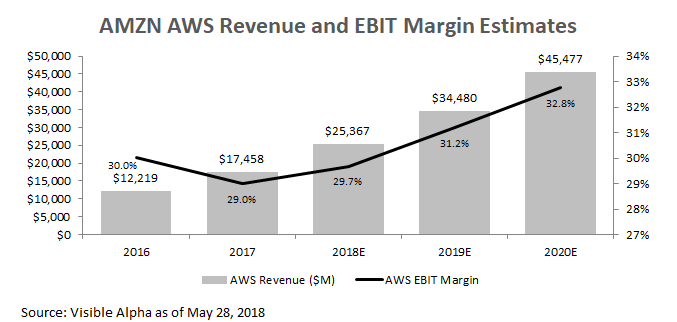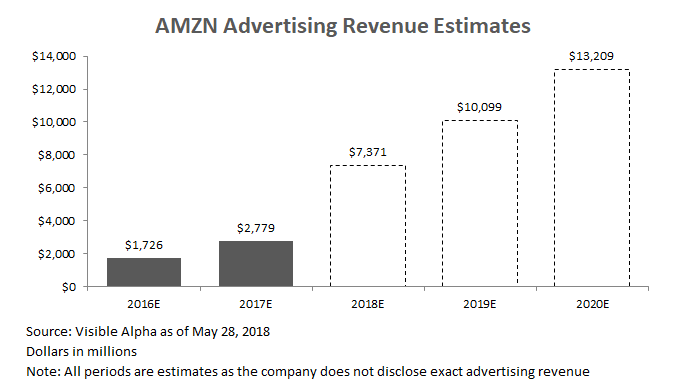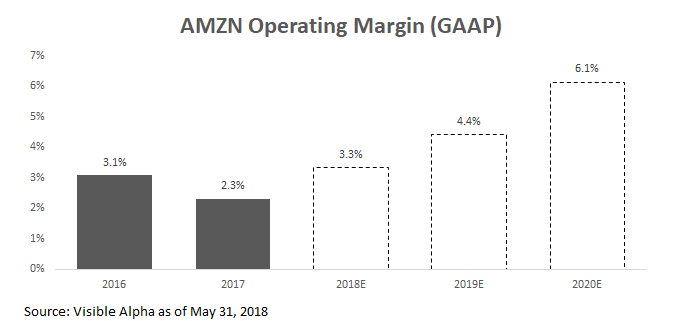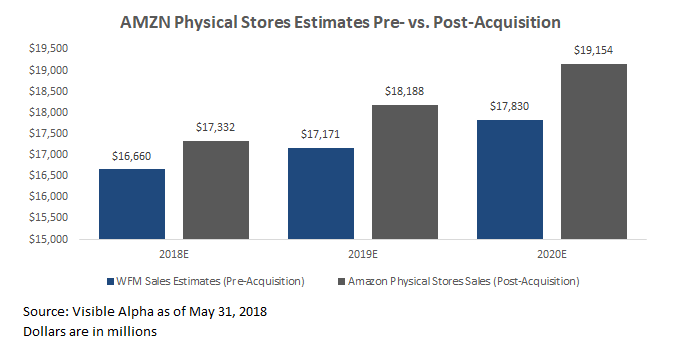High Margin Businesses Could Provide Upside to Profitability
Since expanding beyond its core retail business, Amazon (NASDAQ:AMZN) has gradually disclosed more details on the performance of these growing businesses. In 2015, they disclosed the revenue and profitability of Amazon Web Services, which revealed a much more highly profitable business than initially thought. And last year, they gave some initial hints at their prime membership and advertising revenue, which added another consideration to a growing bull thesis, as I detailed last year. Today, after reporting better-than-expected profitability in 1Q, those businesses now represent a major source of bullishness around the stock - Amazon is not only taking massive share from several large adjacent industries, but these revenue drivers are also high-margin businesses that could provide upside to profitability expectations going forward.
Amazon has several fast-growing, high margin businesses. Amazon Web Services (AWS), is one such business, and much has been made about its strong growth and profitability since its initial disclosure in 2015. However, 1Q results suggested that expectations are still not quite high enough, as both revenue and profitability came in higher than expectations. Analysts have revised AWS estimates upwards as a result, driving the stock higher. Today, analysts expect revenue growth to $45 billion in 2020 and margin expansion of 50-150 basis points.

Amazon's advertising business also outperformed above expectations. Investors have paid attention to the advertising business since last year when Amazon first disclosed its Other segment. In 1Q18, analysts gushed over the accelerating growth of this business, with some analysts estimating growth at north of 90% y/y for the quarter. As mentioned in my previous post, there are several data points that suggest a strong sustainable outlook. First, advertising businesses can potentially become a larger portion of marketplace revenues, as Alibaba (NYSE:BABA)'s advertising and marketing revenues represent roughly 50% of its total revenues. Second, analysts estimate the margins within this business to be north of 50% (the segment that houses Alibaba's advertising revenue has a ~60% margin).
Of note, Amazon made an accounting change that reclassified some of its advertising revenue from a reduction in cost of services to a boost in revenue. This led to a one-time increase in the Other line item. However, even when excluding for this impact, the Other segment came in well-above expectations, suggesting that Advertising still is growing at much faster rate than expectations. With the new accounting change, analysts now estimate the advertising business at $7 billion in revenue in 2018, growing to $13 billion by 2020.
Finally, the mix shift in Amazon's retail business should prove beneficial to profitability as they grow into higher-margin retail categories. Analysts expect categories such as apparel, home furnishings, and private label brands to grow at faster rates and become a larger portion of retail sales. Amazon has had a number of large additions to the marketplace, with apparel companies like Nike (NYSE:NKE) and Under Armour Inc C (NYSE:UA), and furniture companies such as Ethan Allen Interiors Inc (NYSE:ETH) and La-Z-Boy Incorporated (NYSE:LZB). They continue to lure vendors onto the platform as well as test out new initiatives such as Prime Wardrobe.
Putting these sources of margin upside together, analysts now forecast 3.3% total operating margin for Amazon in 2018, growing to 6.1% in 2020.
Amazon's Use of Whole Foods to take Share from Grocery Stores
Since Amazon's announced acquisition of Whole Foods in the middle of last year, analysts have wondered how Amazon will use the brick and mortar retailer to capture share in the massive $700 billion food and beverage sector.
We're beginning to see more actions to leverage Whole Food's brick and mortar presence. On May 31st, Amazon began rolling out 10% discounts on select Whole Foods items already on sale for Amazon Prime members. The initiative was tested in Florida stores and will finish the rollout by the end of this summer to all nationwide stores, including Whole Foods 365 markets.
While some analysts were expecting larger cuts and more aggressive attempts to take share from the grocery market, others have noted that the initiative is indicative of the ways Amazon can make use of Whole Foods. The move could spur more existing Prime members to Whole Foods, and more Whole Foods shoppers to open a Prime account. Additionally, analysts believe customer perception of Whole Foods' pricing is improving as a result of Amazon's actions. Note that Whole Foods has historically been priced at a premium to other conventional grocers, but has begun to close the gap since the acquisition by Amazon. Already, analysts are baking in an "Amazon boost" of several hundred basis points to Whole Food's sales growth estimates prior to the acquisition of the company, as shown below.
The Impact of a Potential Increase in Shipping Rates from the USPS
One of the key risks to the Amazon story is the risk of regulation. While there are several risks, including the imposition of a sales tax on 3P marketplace sellers, or the breakup of Amazon due to its monopsony position, one of the most discussed issues recently is the chance that the Postal Service will increase shipping rates on Amazon. According to numerous media reports, Trump is pushing the Postmaster General to double shipping rates charged to Amazon.
Analysts don't believe this has a high chance of occurring. Over the last several years, strength in the USPS's Shipping and Packages segments (the segments that Amazon's deliveries would go through) have offset weakness in its First Class Mail and Marketing Mail segments (which makes up the majority of its business). Shipping and Packages growth has decelerated more recently, as Amazon has begun to shift more of its last mile delivery to more expensive, faster delivery options from other companies. Should the Postal Service double rates, it would likely speed up the deceleration of its primary growth segment, and only exacerbate the Postal Service's financial losses. Such pricing decisions would also have to be approved by the Postal Regulatory Commission, which considers a number of business factors.
In the off chance that USPS does increase rates, it would likely hurt Amazon's profitability significantly in the near-term. Analysts estimate that Amazon uses USPS for a third to a half of its deliveries. Analysts currently forecast 2018 net shipping costs as a $13 billion loss (or a 570 basis point headwind to operating margin), and this number would likely move much higher in the event of a raise. However, there are a few offsetting factors to consider. First, as mentioned previously, Amazon would likely shift more deliveries to third parties. Second, Amazon's recent Prime membership fee increase (from $99 to $119) would help offset some of the rate increase.



